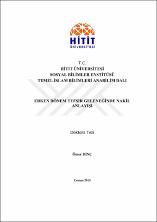Erken dönem tefsir geleneğinde nakil anlayışı
Citation
Dinç, Ö. (2019). Erken dönem tefsir geleneğinde nakil anlayışı ( Doktora Tezi).Abstract
Tefsir tarihi çalışmalarında genel olarak tefsirin bağımsız ve müstakil bir aktarım şeklinin olmadığı üzerinde durulmaktadır. Özellikle tefsirde oluşan birikimin hadis sahasında aktarıldığı düşünülmekte, hatta tefsirin hadis eserlerinde yer alan bir bölüm olarak yansıtılmaya çalışıldığı görülmektedir. Oysa erken döneme dair elimizdeki veriler ve bize ulaşan ilk tefsir çalışmaları bu durumun böyle olmadığını göstermektedir. Hatta ilk döneme dair tarihî bilgileri dikkatli bir şekilde incelediğimiz zaman, tefsirin diğer alanlar içerisinde ortaya çıkan ilk faaliyet sahası olduğu anlaşılmaktadır. Bu bağlamda nüzul sürecinden itibaren erken dönemde oluşan tefsire dair birikimin, kendine özgü yollarla aktarıldığı, bazı zamanlarda farklı etkilere maruz kalsa da bu durumun özünde bir değişikliğe yol açmadığı görülmektedir. Biz de görebildiğimiz bu husustan hareketle erken dönem tefsir nakil anlayışının ortaya çıkışını, süreç içerisinde geçirdiği değişim ve dönüşümleri, geç dönemlerdeki yansımalarını araştırma konusu olarak tespit ettik. Bu çerçevede çalışmamızın ilk bölümünde öncelikle bize ulaşan somut tefsir çalışmalarını inceledik. Ardından tefsir nakil anlayışının ortaya çıkış serüvenini, Kur'an'ın nüzul sürecinden itibaren başlayarak, tefsirin bir disiplin haline geliş sürecine kadar ele aldık. Yaptığımız bu süreç okuması neticesinde tefsir nakil tarzının karakterine dair pek çok özgün hususu tespit ettik. Bunun akabinde tefsir nakil anlayışını belirleyen sosyo-kültürel gelişmelere temas ettik ve bu anlayışın nakil tasavvurunu şekillendirmesi hususundaki rolünü ortaya koyduk. Çalışmamızın ikinci bölümünde ise hadis rivayet formunun, tefsir nakil anlayışına olan etkisi ve onu baskı altına alması hususuna yer verdik. Hicrî III. asırdan sonraki tefsir çalışmalarının rivayet formuna ne kadar uygunluk gösterdiği ve hangi çalışmanın nasıl bir aşamayı temsil ettiği üzerinde durduk. Daha sonra tefsirde rivayet formunun baskın olduğu göstergelerin neler olduğunu çeşitli konular üzerinden incelemeye çalıştık. Son bölümde ise erken dönem tefsir nakil anlayışının geç dönemdeki yansımalarını ortaya koyarak belirli konular çerçevesinde meseleyi netleştirmeye gayret ettik. In the studies of tafsir history, it is generally emphasized that tafsir does not have an independent and unique mode of transmission. In particular, it is thought that the reports formed in the field of tafsir are transmitted in the field of hadith and it is seen that the exegesis is tried to be reflected as a field which is a section in the works of hadith. However, the data available about early period and the first tafsir studies that achieved us show that this is not the case. Moreover, when we carefully examine the historical information about early period, it is understood that tafsir is the first academic field among the other Islamic sciences. In this context, it is seen that the reports of early tafsir starting from the revelation period were transmitted in its own ways and although it has been subjected to different effects at times, this situation did not lead to a fundamental change. Based on this aspect, we have identified the emergence of the early tafsir transmission concept, the changes and transformations it has gone through the process and its reflections in the late periods as a research subject. In this context, in the first chapter, we initially examined the concrete tafsir works that reached us. Then, we discussed the emergence of the conception of tafsir transmission from the beginning of the revelation of the Qur'an to the tafsir's becoming a discipline. As a result of this process reading, we identified many original aspects of the character of the tafsir transmission style. Subsequently, we touched upon socio-cultural developments which determine the understanding of tafsir transmission. Also, we have demonstrated the role of this understanding in shaping the concept of transmission. In the second chapter, the effect of the hadith narration form on the concept of tafsir transmission and putting it under pressure has been included. We emphasized to what extent the tafsir works after the 3rd century of hijri corresponded to the narrative form and which studies represented whichstage. Afterwards, we tried to examine on various aspects what the indicators in which the narrative form is dominant in the tafsir field are. In the last chapter, we put forward the reflections of the concept of early tafsir transmission to the late period and tried to clarify the issue within the framework of certain issues


















